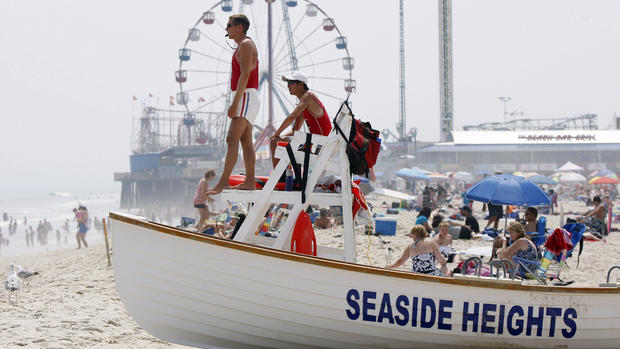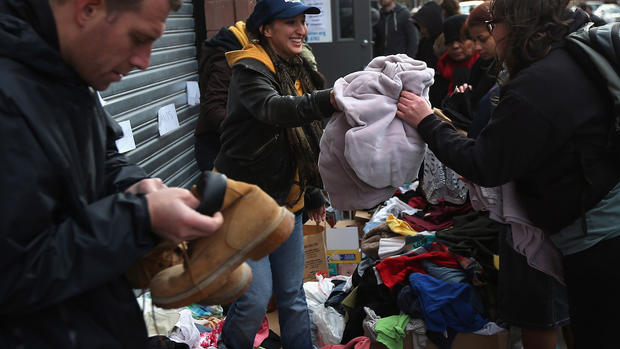Some evacs ordered ahead of predicted NE storm
NEW YORK From trying to figure out where people will live, to how they will be able to vote, how to shorten lines for gasoline, and when all the lights will finally come on, government officials were still facing multiple fronts in the efforts to recover from superstorm Sandy early Tuesday. All that, and there's another storm coming.
A nor'easter packing heavy rain and gusts of 50 to 60 mph was headed for the area Wednesday, threatening more flooding and power outages that could undo some of the repairs made in the past few days.
Authorities in Brick Township, N.J. have issued a mandatory evacuation order for everyone who lives in the low-lying, waterfront areas of the town due to the predicted nor'easter, reports CBS station KYW-TV, in Philadelphia. Anyone in the area of the town that's prone to flooding or storm surge must evacuate by Tuesday at 6 p.m., the order says. Sandy ravaged the township as it moved through last week.
Where to house potentially tens of thousands of people left homeless by the storm is the most pressing crisis, as cold weather sets in.
"It's not going to be a simple task. It's going to be one of the most complicated and long-term recovery efforts in U.S. history," said Mark Merritt, president of Witt Associates, a Washington crisis management consulting firm founded by former Federal Emergency Management Agency Director James Lee Witt.
FEMA said it has already dispensed close to $200 million in emergency housing assistance and has put up 34,000 people in New York and New Jersey in hotels and motels. But local, state and federal officials have yet to lay out a specific, comprehensive plan for finding them long-term places to live. And given the scarcity and high cost of housing there and the lack of open space, it could prove a monumental undertaking.
Sandy killed more 100 people in 10 states but vented the worst of its fury on New Jersey and New York. A week after the storm slammed the mid-Atlantic and the Northeast, more than 1 million homes and businesses remained without power.
With the temperatures dropping into the 30s overnight, people in dark, unheated homes were urged to go to overnight shelters or daytime warming centers.
Because so many people have been displaced by the storm, New York Gov. Andrew Cuomo issued an executive order allowing people to vote in Tuesday's statewide and presidential elections at any polling place in the state. New Jersey had already taken similar measures.
"Just because you are displaced doesn't mean you are disenfranchised," Cuomo said. "Compared to what we have had to deal with in the past week, this will be a walk in the park when it comes to voting."
As for long-term housing for the homeless, Homeland Security Secretary Janet Napolitano said Monday that the government is looking into using everything from hotels and motels to FEMA trailers and prefab homes.
"Given the extent of need, no option is off the table," she said. "All of them will have some place in this puzzle."
Officials have yet to even establish the magnitude of the problem.
In New York City, Mayor Michael Bloomberg said Monday that officials are going door-to-door in hard-hit areas to assess the need for shelter. He said the worst-case estimate is 40,000 people, half of them in public housing.
But he said as many as 20,000 will probably get their heat and power back within a few days. Ultimately, the number of people who need longer-term housing could be under 10,000, he said.
In New Jersey, state officials said they are still trying to figure out how many people will need long-term housing. At least 4,000 residents were in New Jersey shelters.
Meanwhile, relief from long lines and higher gas prices may be in the offing for drivers in Sandy-damaged areas.
A week after Superstorm Sandy hit the area, the price of gas had increased 10 cents per gallon or more in the New York City area and in hard-hit parts of New Jersey. Images of long lines of cars and interviews with frustrated drivers have become staples in news coverage of the storm's aftermath.
But across the U.S. the price of gasoline was falling — fast. It fell 7 cents this past week and has declined almost 9 percent in a month to $3.47 per gallon. The national average should be only slightly higher this Election Day than a year ago. That's due to a dramatic drop in the price of wholesale gasoline and low demand from a combination of cautious consumers and improving automotive fuel efficiency.
Prices should fall further in the coming weeks, according to Tom Kloza, chief oil analyst at the Oil Price Information Service. Even people in the Northeast now standing or sitting in long lines for gas -- what he calls the "hysteria" in New York and New Jersey -- should catch a break.
On Sunday, the Energy Department estimated that 27 percent of all gas stations across New York City, Long Island and New Jersey did not have gas to sell. That's down from 38 percent on Saturday. The situation improved as more stations regained electricity and extra supplies were brought in. State and local officials working with the U.S. Coast Guard started this weekend to off-load 28 million gallons of fuel from tankers — about what the metro area burns on a typical day.
Phillips 66, however, said late Monday that its refinery in Linden, N.J., won't resume normal operations for up to three weeks. But it said it has adequate supplies of fuel on hand and has taken steps to ensure fuel deliveries to its Linden terminal.
The Defense Department also set up mobile fuel stations around the New York metro area to distribute 12 million gallons of gasoline and 10 million gallons of diesel to run generators. The gas is free, and each person can take up to 10 gallons.
Those moves should begin to gradually lead the area back to normal. Then, Kloza said, New York area drivers will able to take advantage of the price relief those in the rest of the U.S. already see. For now, residents of Nassau Country on Long Island will pay about 14 cents more per gallon than a week ago while drivers in Bergen County in northeast New Jersey shell out about 13 cents more.

